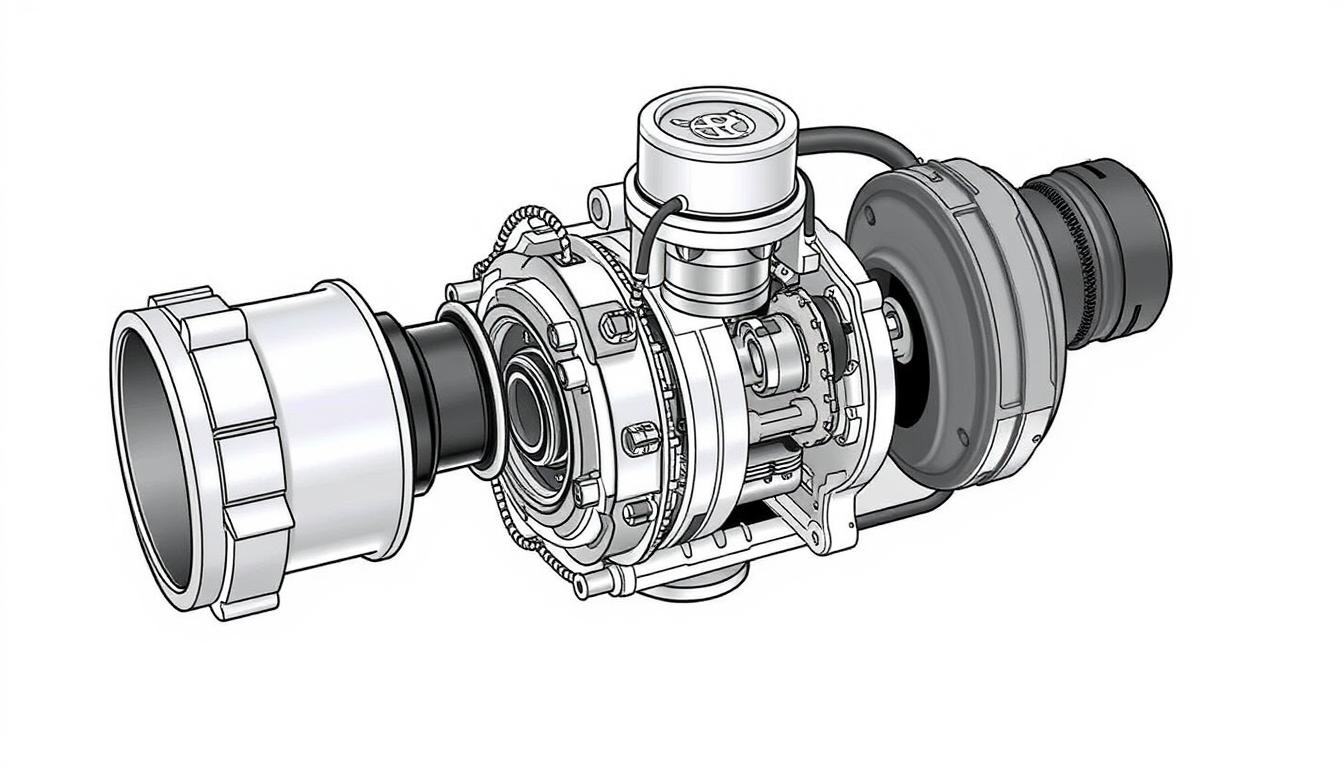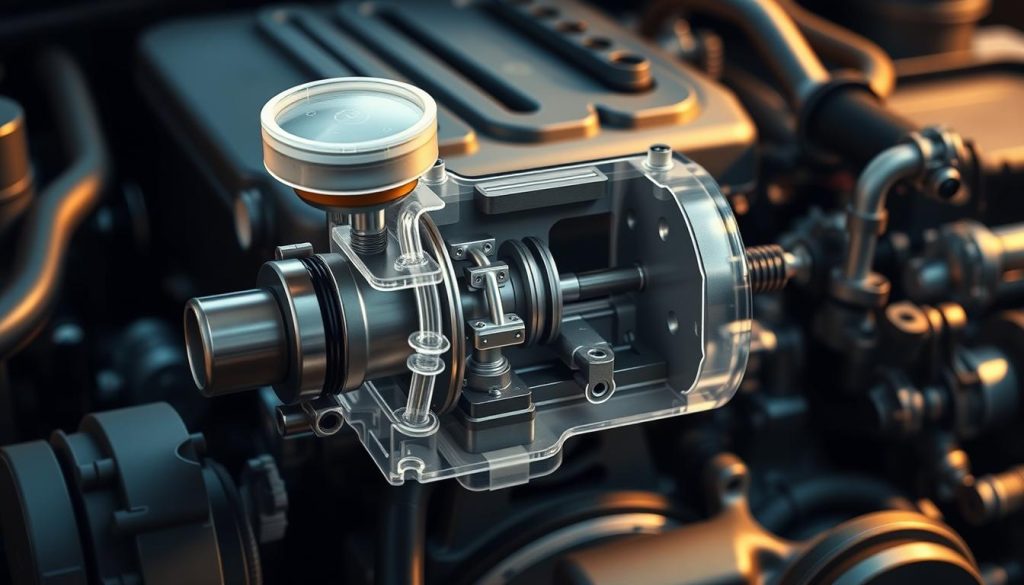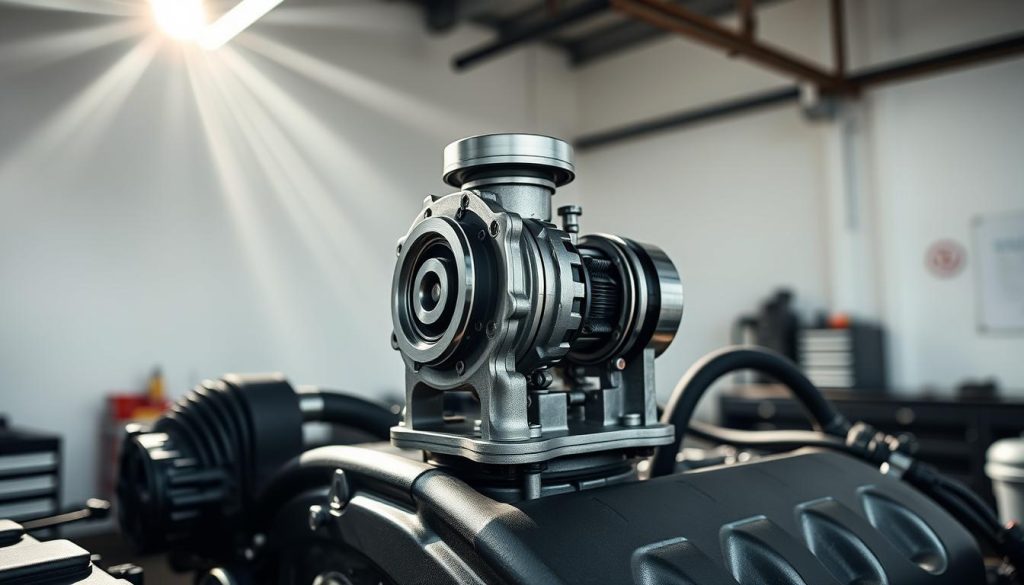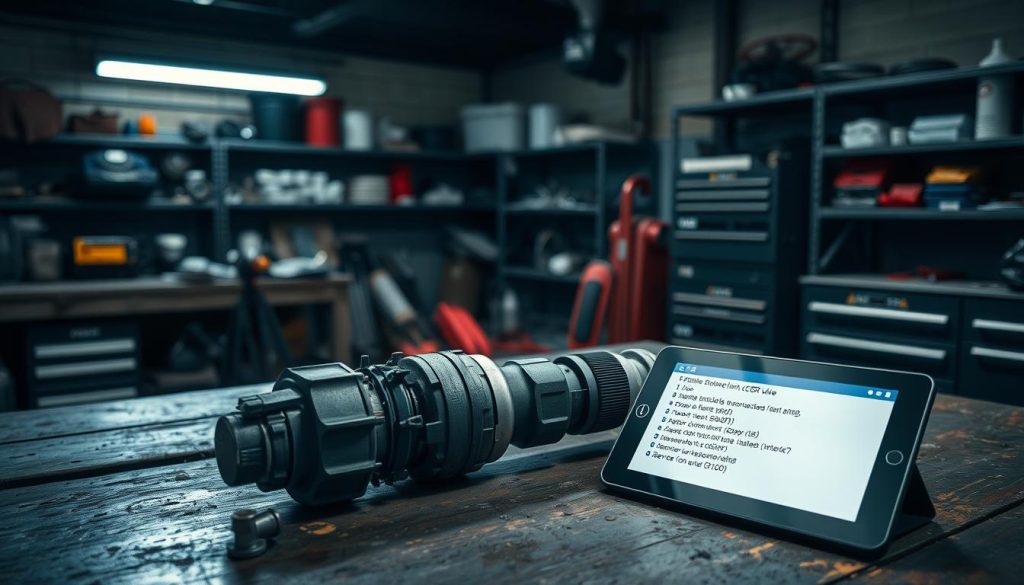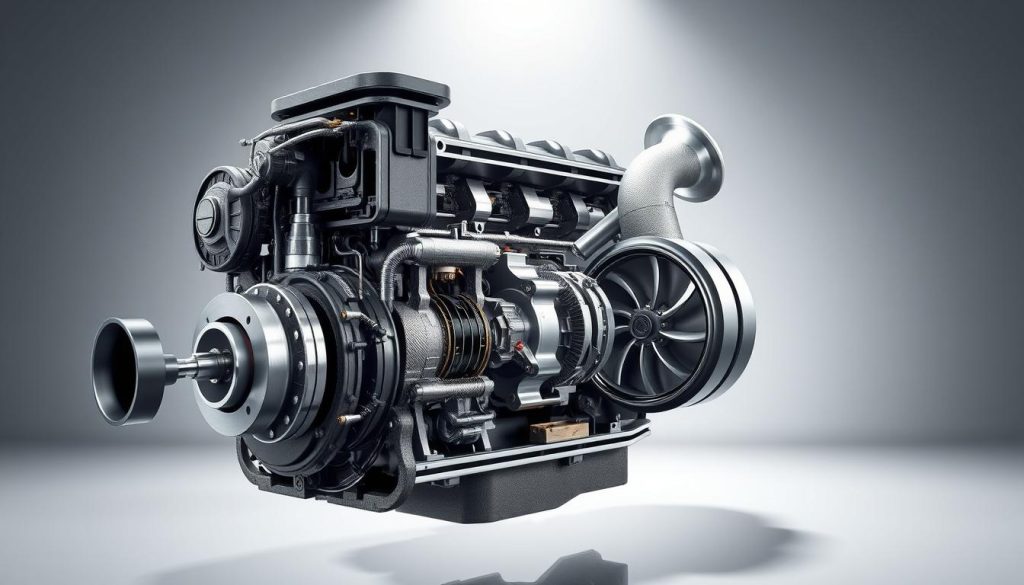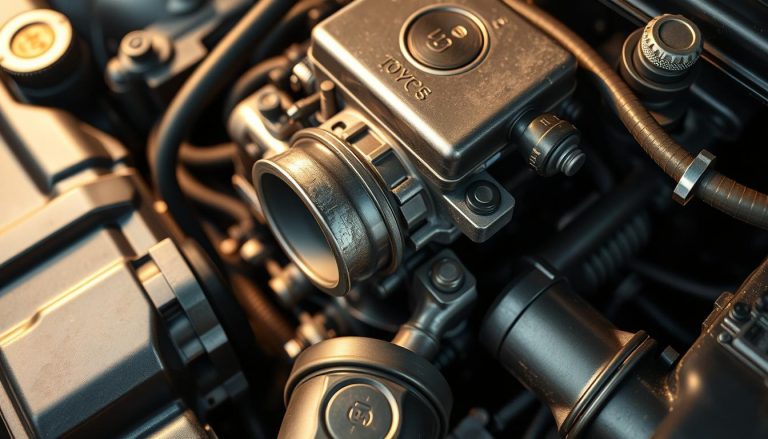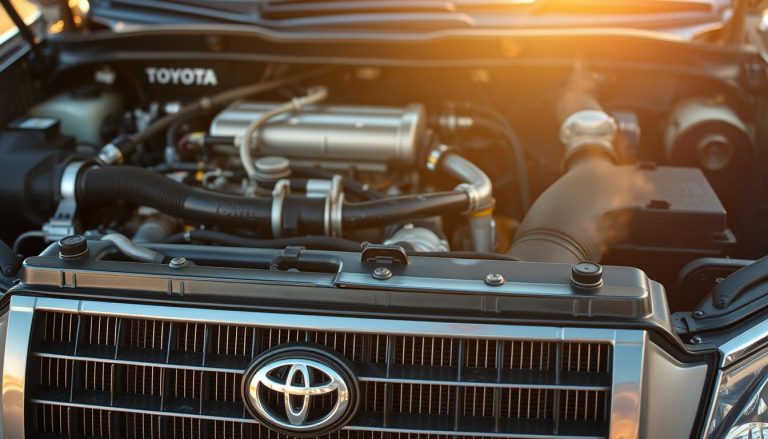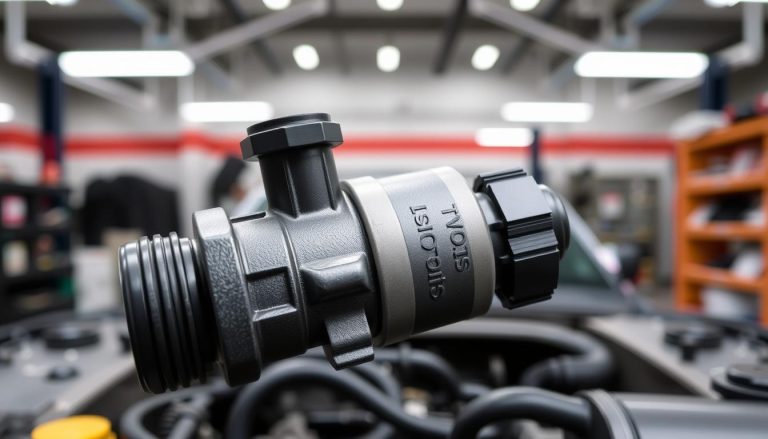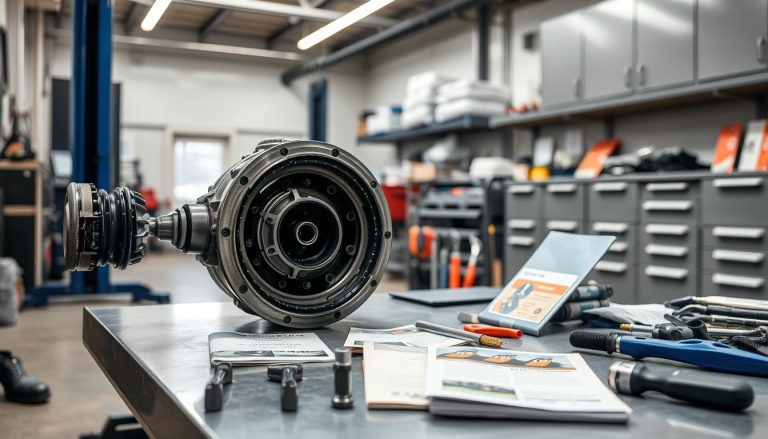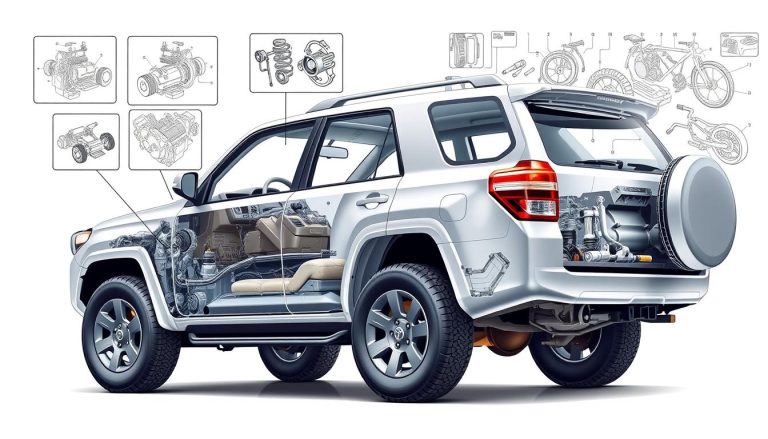Toyota EGR Valve Issues & Troubleshooting
Toyota cars are known for being reliable. Yet, they can have problems with parts like the Exhaust Gas Recirculation (EGR) valve. This part is key to keeping your car running well and meeting emissions standards.
The EGR valve helps cut down on harmful emissions by sending some exhaust gases back into the engine. Over time, it can run into issues that affect your car’s performance. This guide helps both new and experienced car owners understand EGR valve problems, signs of trouble, and how to fix them.
This section explains why the EGR valve is important in Toyota cars, common problems, and how to solve them. Knowing how to handle Toyota EGR valve issues helps keep your engine running smoothly and meets emission rules.
Introduction to Toyota EGR Valve
Knowing how an EGR valve works is key to keeping your engine running well and reducing harmful emissions in Toyota cars. The EGR (Exhaust Gas Recirculation) valve is a vital part. It helps your engine run efficiently and meets environmental rules.
What is an EGR Valve?
The EGR valve is a key part of your car’s emission control system. It recirculates some exhaust gases back into the engine. This lowers the combustion temperature and cuts down on harmful pollutants like nitrogen oxides (NOx).
In short, the EGR valve keeps emissions low and your engine running smoothly.
Importance of the EGR Valve in Toyota Vehicles
In Toyota cars, the importance of the EGR valve is huge. It controls the combustion process, cuts down NOx emissions, and meets tough environmental standards. Also, the Toyota EGR valve functions best when it helps the engine use fuel better and keeps the intake clean.
Regular checks and knowing how these valves work are essential for any car owner. They help keep your vehicle in great shape.
Common Toyota EGR Valve Problems
Toyota EGR valve problems can really hurt your car’s performance. They often come from carbon buildup, electronic faults, and vacuum line issues. Knowing about these issues is key to keeping your Toyota’s engine running well.
Carbon Buildup
EGR valve carbon buildup is a big problem for Toyotas. Carbon deposits block airflow over time, making the valve work poorly. This can make your car idle roughly, use more fuel, and pollute more.
Electronic Faults
Electronic faults in EGR valves can also cause big headaches. These problems often start with sensor failures, wiring issues, or control module malfunctions. When these parts fail, the EGR valve doesn’t work right. This leads to issues like bad idling, slow acceleration, and a check engine light.
Vacuum Line Issues
Vacuum line problems are another common issue with Toyota EGR valves. Issues like wear, disconnections, or leaks can stop the valve from working. These problems can make your engine run poorly and increase emissions, just like carbon buildup and electronic faults.
Symptoms of a Failing Toyota EGR Valve
Spotting signs of a failing EGR valve early can prevent big repairs and high costs. Here are the common signs to look out for:
Check Engine Light
The check engine light is a clear sign of EGR valve trouble. The engine’s computer notices problems in the EGR system and lights up the warning. If you ignore this light, bigger problems could follow.
Rough Idle and Stalling
A failing EGR valve can make your engine idle roughly or stall. This happens because the valve messes with the air-fuel mix, causing the engine to act strangely.
Poor Acceleration
Another sign is poor acceleration. You might feel a big lag when you press the gas pedal. This makes it hard to get up to speed quickly. It’s usually because the EGR system isn’t working right.
Increased NOx Emissions
High nitrogen oxide (NOx) emissions are a big worry. A bad EGR valve can’t send exhaust gases back into the engine, leading to more NOx. This is bad for the environment and can cause a failed emissions test.
| Symptom | Description |
|---|---|
| Check Engine Light | Triggered when the ECU detects EGR system irregularities. |
| Rough Idle and Stalling | The engine may idle roughly or stall due to air-fuel mixture disruptions. |
| Poor Acceleration | Noticeable lag when pressing the accelerator due to EGR system issues. |
| Increased NOx Emissions | Higher levels of nitrogen oxide emissions indicating EGR valve problems. |
Understanding EGR Valve Operation
To cut down on harmful emissions and save fuel, knowing how EGR valves work is key. The Exhaust Gas Recirculation (EGR) valve sends some exhaust gases back into the engine. This lowers the combustion temperature and cuts down on NOx gases. Let’s explore how EGR valves function and the critical role the Engine Control Unit (ECU) plays in this process.
How EGR Valves Work
EGR valves open and close to let the right amount of exhaust gas into the intake manifold. This action reduces oxygen in the combustion chamber, leading to lower combustion temperatures. But how do EGR valves actually work? The engine’s optimal conditions trigger the EGR valve to open. This cycle keeps the engine running smoothly and meets environmental standards.
The Role of the ECU
The Engine Control Unit (ECU) is the brain behind the EGR system’s efficiency. It watches engine parameters like RPM, temperature, and load to control when the EGR valve opens or closes. This ECU and EGR valve interaction optimizes the recirculation process. It prevents engine knocking and boosts fuel economy. In essence, the ECU orchestrates the EGR system’s performance, ensuring everything works together perfectly.
- The ECU ensures precise timing for EGR valve operation.
- Optimal coordination of exhaust gas recirculation to maintain engine balance.
- The system overall helps in reducing noxious emissions and enhance fuel efficiency.
Why EGR Valves Fail in Toyota Vehicles
EGR valves are key in cutting down emissions and keeping your Toyota engine running smoothly. Knowing why they fail can help you avoid problems and keep your EGR valve in top shape. Several things can cause EGR valves to fail in Toyotas.
Harsh Operating Conditions
The life of an EGR valve is tough, facing high heat and pressure. These harsh conditions can wear it down fast. Regular checks and maintenance can help protect your EGR valve from these stresses.
Carbon Deposits
Carbon buildup is a big reason for EGR valve failure. It can block the valve over time. Cleaning your EGR valve often is key to avoiding these blockages.
Diaphragm Ruptures
EGR valves also have diaphragms that can break or get damaged. A broken diaphragm means the valve won’t work right. Keeping an eye on your diaphragms and doing regular maintenance can prevent these issues.
Types of EGR Valves in Toyota Vehicles
It’s important to know about the different EGR valves in Toyota cars. Toyota mainly uses two types: digital and vacuum-operated valves. Each type works differently and is used in various engines.
Vacuum-operated EGR valves use engine vacuum to control exhaust gas flow. They are common in older Toyotas. But, they need regular checks for leaks and diaphragm health.
Digital EGR valves, on the other hand, are more advanced. They are found in newer Toyotas and are controlled by the engine’s computer. This makes them more efficient and cuts down on emissions.
| Type of EGR Valve | Operation Method | Application |
|---|---|---|
| Vacuum-Operated EGR Valve | Engine Vacuum | Older Toyota Models |
| Digital EGR Valve | Electronic Control | Modern Toyota Vehicles |
Both EGR valve types are key in Toyota’s EGR systems. They help lower NOx emissions and boost engine performance. Keeping up with maintenance and knowing your EGR valve type is vital for your engine’s health.
Troubleshooting Toyota EGR Valve Issues
Fixing EGR valve problems in Toyota cars needs a few important steps. It’s key to follow a clear plan to get it right. We’ll look at using diagnostic tools, checking vacuum lines, and inspecting electrical connections.
Using Diagnostic Tools
Starting with the right tools is essential. These tools help by reading error codes and checking the ECU. OBD-II scanners are often used to find EGR-related errors. This helps avoid unnecessary repairs.
Inspecting Vacuum Lines
Next, check the vacuum lines connected to the EGR valve. These lines are vital for the EGR system’s work. Look for leaks, blockages, or wear. A simple check and pressure test can find hidden problems.
Checking Electrical Connections
Lastly, don’t forget to check the electrical connections. Bad connections can cause EGR valve problems. Make sure wiring and connectors are secure and clean. This ensures the EGR valve works right.
| Step | Action | Tools Needed |
|---|---|---|
| 1 | Using Diagnostic Tools | OBD-II Scanner |
| 2 | Inspecting Vacuum Lines | Pressure Tester |
| 3 | Checking Electrical Connections | Multimeter |
Steps to Clean a Toyota EGR Valve
To keep your Toyota running well, it’s key to take care of the EGR valve. Cleaning it regularly helps avoid performance problems. Here’s a step-by-step guide on what tools and materials you need, and how to clean it.
Required Tools and Materials
- Socket wrench set
- Flathead and Phillips screwdrivers
- Protective gloves
- Safety glasses
- Carburetor cleaner or EGR valve cleaner spray
- Soft bristle brush or old toothbrush
- Rags or paper towels
- New gasket (if necessary)
Make sure you have all these items ready before you start. Being prepared helps you clean your Toyota EGR valve safely and efficiently.
Cleaning Process
- Turn off the engine and disconnect the battery. This keeps you safe from accidental starts or electrical problems.
- Find the EGR valve. If you’re not sure where it is, check your Toyota’s manual.
- Remove the EGR valve. Use a socket wrench to unbolt it. Be careful not to lose any small parts or spacers.
- Inspect the valve. Look for carbon build-up or damage. If the gasket is old, replace it with a new one.
- Clean the EGR valve. Spray carburetor cleaner or EGR valve cleaner on it. Then, use a soft bristle brush to remove carbon deposits.
- Rinse and dry. Wipe the valve clean with rags or paper towels. Make sure it’s dry before putting it back together.
- Reinstall the EGR valve. Place it back carefully, making sure the gasket is right. Tighten the bolts well.
- Reconnect the battery and start the engine. Listen for any odd noises or performance issues. This checks if the cleaning worked.
Cleaning the EGR valve regularly is vital for your vehicle’s performance. Stick to these maintenance tips to avoid expensive repairs and keep your Toyota running smoothly.
How to Replace a Faulty Toyota EGR Valve
Replacing a Toyota EGR valve needs careful preparation and specific steps. We will cover safety measures, removing the old valve, installing the new one, and resetting the ECU.
Preparation and Safety
First, get all the tools and safety gear ready. Work in a well-ventilated area and disconnect the battery to avoid electrical risks. Wear gloves and safety goggles to protect yourself.
Removing the Old Valve
Find the EGR valve near the intake manifold. Disconnect vacuum lines and electrical connectors. Use the right wrench or socket to unscrew the bolts. Remove the old valve carefully and set it aside.
Installing the New Valve
Align the new EGR valve with the mounting points. Tighten the bolts evenly to prevent leaks. Reconnect vacuum lines and electrical connectors securely.
Resetting the ECU
After installing the new valve, reset the ECU. Disconnect the battery negative terminal for 15-20 minutes. Reconnect it and start the engine. Let it idle for a few minutes for the ECU to adjust.
| Step | Actions |
|---|---|
| Preparation | Gather tools, ensure safety measures, disconnect battery |
| Removing the Old Valve | Locate EGR valve, disconnect attachments, unscrew bolts, remove valve |
| Installing the New Valve | Align new valve, secure bolts, reconnect lines and connectors |
| ECU Reset | Disconnect battery for 15-20 minutes, reconnect, idle engine |
Preventive Maintenance for Toyota EGR Valves
Keeping Toyota EGR valves in good shape is key. Regular maintenance helps avoid problems like carbon buildup and diaphragm issues. We’ll talk about two main steps: checking the valve regularly and cleaning it on time.
Regular Inspections
Checking the EGR valve often is vital. It helps find and fix issues early. Technicians look for wear, carbon buildup, or damage. They also check vacuum lines and electrical connections.
- Check for excessive carbon buildup
- Inspect for mechanical damage
- Evaluate vacuum lines and connections
Timely Cleaning
Cleaning EGR valves regularly is important for engine performance. It removes carbon deposits that block the valve. Clean every 30,000 miles or as your car’s manual suggests.
Regular checks and cleaning extend the EGR valve’s life. This keeps your engine running smoothly.
Impact of EGR Valve Issues on Engine Performance
The Exhaust Gas Recirculation (EGR) valve is key in Toyota vehicles. It helps cut down emissions and boosts engine performance. But, when it fails, it can cause many problems.
Effects on Fuel Efficiency
Fuel efficiency is a big deal for engine performance. The EGR valve plays a big role here. It recycles exhaust gases to improve fuel use. But, if it breaks, fuel use goes up, making your car less efficient and costing more to run.
Increased Emissions
A bad EGR valve also means more harmful emissions. It’s meant to cut down on nitrogen oxides by recycling them. But, if it’s not working right, emissions go up. This can lead to failing emissions tests, pollution, and fines.
Potential Engine Damage
But there’s more. A faulty EGR valve can also harm your engine. It can cause your car to idle roughly, stall, and run hotter. If not fixed, this can damage your engine badly, costing a lot to fix or even replace.
Diagnosing EGR Valve-Related Fault Codes
It’s important to find and fix EGR valve fault codes in Toyota cars. This keeps the engine running well and cuts down on emissions. Knowing these codes helps fix EGR problems quickly and right.
Common EGR Fault Codes
There are many fault codes related to the EGR valve. Here are some common ones:
- P0401 – Insufficient EGR Flow
- P0402 – Excessive EGR Flow
- P0404 – EGR Circuit Range/Performance Problem
- P0405 – EGR Sensor A Circuit Low
Interpreting the Codes
Understanding these codes is vital for fixing EGR problems. Each code shows a different issue. This helps in finding and fixing the problem:
- P0401: Shows a blockage in the EGR passage.
- P0402: Means the EGR valve is stuck.
- P0404: Points to problems with the EGR circuit.
- P0405: Means the EGR sensor is not working right.
Actionable Steps Post Diagnosis
After finding the codes, here’s what to do next:
- Inspect and clean: Clean out carbon buildup in the EGR valve or its paths.
- Test the valve: Check if the valve moves freely to see if it’s stuck.
- Check electrical connections: Make sure all connections and wiring are good.
- Replace if necessary: If cleaning and checking don’t work, you might need a new EGR valve.
How to Test Toyota EGR Valves
It’s important to check the EGR valve in your Toyota to keep your engine running well and reduce emissions. This guide will show you how to test EGR valves. You’ll learn about manual EGR valve testing and using diagnostic scanners for EGR.
Manual Testing Methods
Manual EGR valve testing is easy and can spot common problems. It involves looking at the valve and its parts. Here’s what to do:
- Visual Inspection: Look for carbon buildup or damage on the EGR valve.
- Vacuum Test: Use a vacuum pump on the EGR valve. If it moves and holds vacuum, it’s working right.
- Valve Operation: Open and close the valve by hand. It should move easily without any resistance.
Using Diagnostic Scanners
Diagnostic scanners give more detailed info and help find specific problems. They read error codes from the ECU. Here’s how to use them:
- Connect the Scanner: Plug the scanner into the OBD-II port under the dashboard.
- Retrieve Codes: Turn on the ignition and the scanner. Look for EGR-related codes in the ECU.
- Analyze Data: Check the scanner’s data for fault codes or sensor readings related to the EGR system.
- Functional Test: Use the scanner to control the EGR valve. Watch how it responds in real-time.
The table below compares manual testing with using diagnostic scanners:
| Testing Method | Advantages | Disadvantages |
|---|---|---|
| Manual Testing | Simple, cost-effective, no special tools needed | Limited to visible/mechanical issues, not as precise |
| Using Diagnostic Scanners | Accurate, detailed, identifies ECU codes | Requires expensive equipment and technical knowledge |
Using both manual EGR valve testing and diagnostic scanners is the best way to find problems. Regular checks keep your Toyota’s EGR system working well. This ensures your engine runs smoothly and reliably.
Interaction of EGR Valves with Other Engine Components
EGR valves play a big role in Toyota engines. They work with turbochargers, intake manifolds, and emission control systems. Knowing how they interact helps us understand the importance of EGR valve maintenance.
Turbochargers
EGR valves and turbochargers are a team. They help the engine run better and more efficiently. The EGR system sends some exhaust gases back into the engine.
This lowers the engine’s temperature. It’s important for turbochargers because too much heat can hurt them. EGR valves keep the turbochargers working well for longer.
Intake Manifold
EGR valves also affect the intake manifold. They mix exhaust gases with air coming into the engine. This helps cool the gases and cuts down on harmful emissions.
But, over time, carbon can build up. This can block airflow and make the engine less efficient. Keeping the EGR system clean helps the intake manifold work better.
Emission Control Systems
EGR valves are key to controlling emissions. They reduce harmful NOx emissions by mixing exhaust gases with engine air. This helps vehicles meet strict emission rules.
It’s important to keep EGR valves working right. This ensures the engine’s emission control system works well.
Long-Term Impact of Ignoring EGR Valve Issues
Ignoring EGR valve problems in your Toyota can cause serious damage. It’s important to know the risks to avoid expensive repairs later.
Engine Wear and Tear
Ignoring EGR valve issues can harm your engine a lot. Problems with the EGR valve can make engine parts wear out faster. This can damage your engine and shorten your car’s life.
Failed Emission Tests
A bad EGR valve can make your car pollute more. This is because it doesn’t work right to cut down on harmful emissions. If your car fails an emissions test, you’ll face fines and have to fix it. This shows how important EGR and emissions testing are.
| Factors | Potential Consequences of Ignoring EGR Valve Problems |
|---|---|
| Engine Components | Increased wear, leading to costly repairs |
| Combustion Temperature | Higher temperatures causing engine parts to degrade faster |
| Vehicle Emissions | Non-compliance with emissions standards, increased pollution |
Fixing EGR valve problems early can save you a lot of money. Regular checks and quick fixes can keep your car running well and meet environmental rules.
Professional Help vs. DIY: Which is Better for EGR Valve Issues?
Deciding between getting professional help or doing it yourself for EGR valve problems in your Toyota can be tough. Knowing when to ask for help and what DIY steps you can do safely is key. It greatly affects how well your repairs work and how long your car will last.
When to Seek Professional Help
It’s wise to get professional help for EGR issues when they’re complex. Experts can find problems that you might not see yourself. For electronic EGR valves, you need special tools and knowledge, like for fixing electronic faults or fixing vacuum lines.
If your car’s performance is really bad or the EGR valve keeps failing, getting a pro might be better. It could lead to a more lasting fix.
DIY Steps You Can Take
Trying to fix EGR valve problems yourself can save money for small issues. Simple tasks like cleaning the EGR valve or checking and fixing vacuum lines can be done with basic tools and some mechanical knowledge. Always check your car’s manual and follow safety rules.
If you’re not sure, comparing DIY and professional repair can help. It shows if DIY is right for you and the problem’s complexity.
In the end, deciding when to get help for EGR problems depends on the problem’s complexity and what you can do. DIY is good for simple issues, but for serious problems, a pro is safer and more reliable.
Conclusion
Understanding and maintaining your Toyota EGR valve is key for your vehicle’s best performance and life. This article has covered everything from common problems and symptoms to detailed troubleshooting and maintenance steps. By following these tips, you can handle issues like carbon buildup, electronic faults, and vacuum line problems confidently.
Regular checks and preventive actions can prevent big problems. Simple steps like cleaning on time and using the right tools can keep your EGR system healthy. Ignoring this important part can harm your fuel efficiency, emissions, and engine health.
In summary, whether you do it yourself or get professional help, being proactive and acting fast is the main thing. These final thoughts on EGR valve maintenance highlight the need to stay informed and watch your EGR valve’s condition. By doing so, you’ll make sure your Toyota runs well and efficiently.
FAQ
What is an EGR Valve?
An Exhaust Gas Recirculation (EGR) valve is a part in Toyota cars. It sends some exhaust gases back into the engine. This helps lower NOx emissions and keeps engine temperatures in check, making the engine more efficient and eco-friendly.
What are common problems with Toyota EGR valves?
Toyota EGR valves often face issues like carbon buildup, electrical problems, and vacuum line issues. These problems can stop the valve from working right, leading to poor engine performance and more emissions.
What are the symptoms of a failing Toyota EGR valve?
Signs of a failing EGR valve include a check engine light, rough idling, stalling, poor acceleration, and more NOx emissions. These signs mean you should check and fix the valve quickly.
How does carbon buildup affect the EGR valve?
Carbon buildup can block the EGR valve, stopping it from working. This can cause problems like a rough idle, bad fuel efficiency, more emissions, and even engine damage if not fixed fast.
What role does the ECU play in EGR valve operation?
The Engine Control Unit (ECU) controls the EGR valve. It checks engine data and adjusts the valve to improve performance and emissions. A faulty ECU can harm the EGR valve’s function.
How do you troubleshoot Toyota EGR valve issues?
To fix Toyota EGR valve problems, use diagnostic tools to find fault codes. Check vacuum lines for leaks or blockages. Also, inspect electrical connections for corrosion or disconnection.
What tools and materials are needed to clean a Toyota EGR valve?
Cleaning a Toyota EGR valve needs basic tools, a carbon cleaner, a brush, and safety gear like gloves and glasses. Cleaning removes carbon deposits to keep the valve working well.
How do you replace a faulty Toyota EGR valve?
Replacing a bad EGR valve involves several steps. First, prepare with tools and safety gear. Then, remove the old valve, install the new one, and reset the ECU. This ensures the new valve works right with the vehicle.
What preventive maintenance can be done to enhance the longevity of Toyota EGR valves?
To keep Toyota EGR valves in good shape, do regular checks and clean them to avoid carbon buildup. Also, watch for vacuum line problems or electrical faults and fix them quickly.
How do EGR valve issues impact engine performance?
EGR valve problems can hurt engine performance by lowering fuel efficiency, increasing harmful emissions, and causing engine damage over time. Fixing these issues is key to keeping your vehicle running well.
What are the different types of EGR valves in Toyota vehicles?
Toyota cars use different EGR valves, like digital and vacuum-operated ones. Each type fits specific engines and helps control emissions.
How do you diagnose EGR valve-related fault codes?
To diagnose EGR valve fault codes, use a diagnostic scanner to read them. Then, understand what each code means and take steps to fix the problem, like cleaning carbon buildup or checking electrical connections.
How do you test a Toyota EGR valve for functionality?
Testing a Toyota EGR valve involves manual checks and using diagnostic scanners. Look for mechanical issues and make sure the valve works with the ECU as it should.
When should you seek professional help for EGR valve issues?
If you face complex electronic faults, have a lot of carbon buildup, or need to replace the valve but don’t have the right tools or know-how, get professional help.
What are the long-term consequences of neglecting EGR valve issues?
Ignoring EGR valve problems can lead to faster engine wear, more emissions, failed emissions tests, and serious engine damage. Fixing issues early is vital to avoid these problems.

